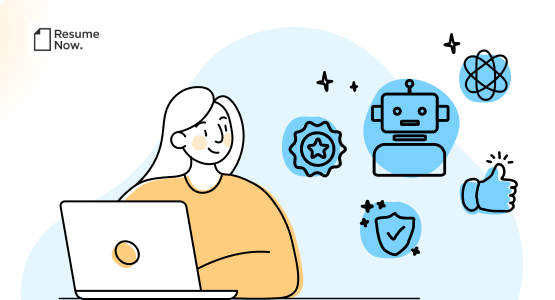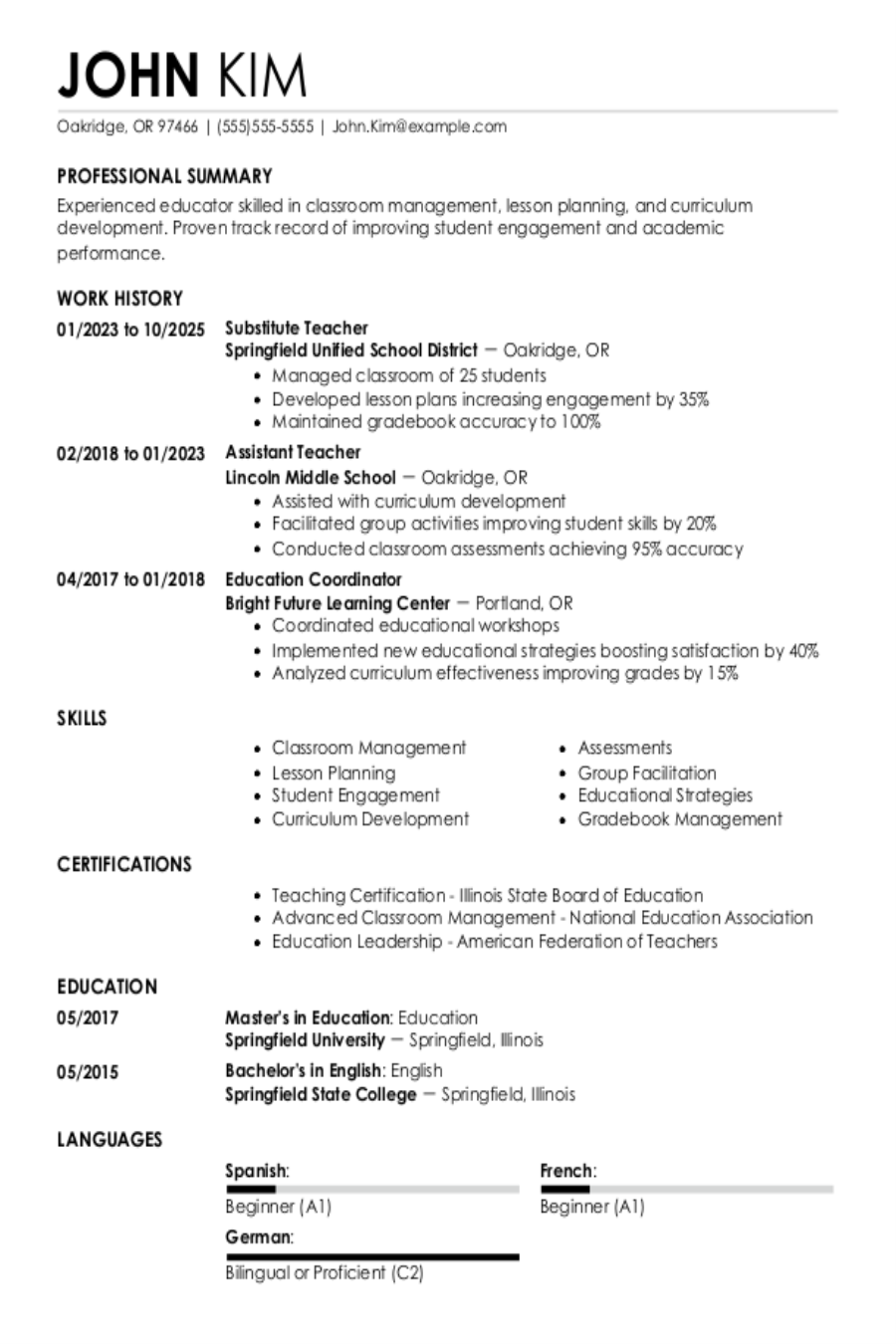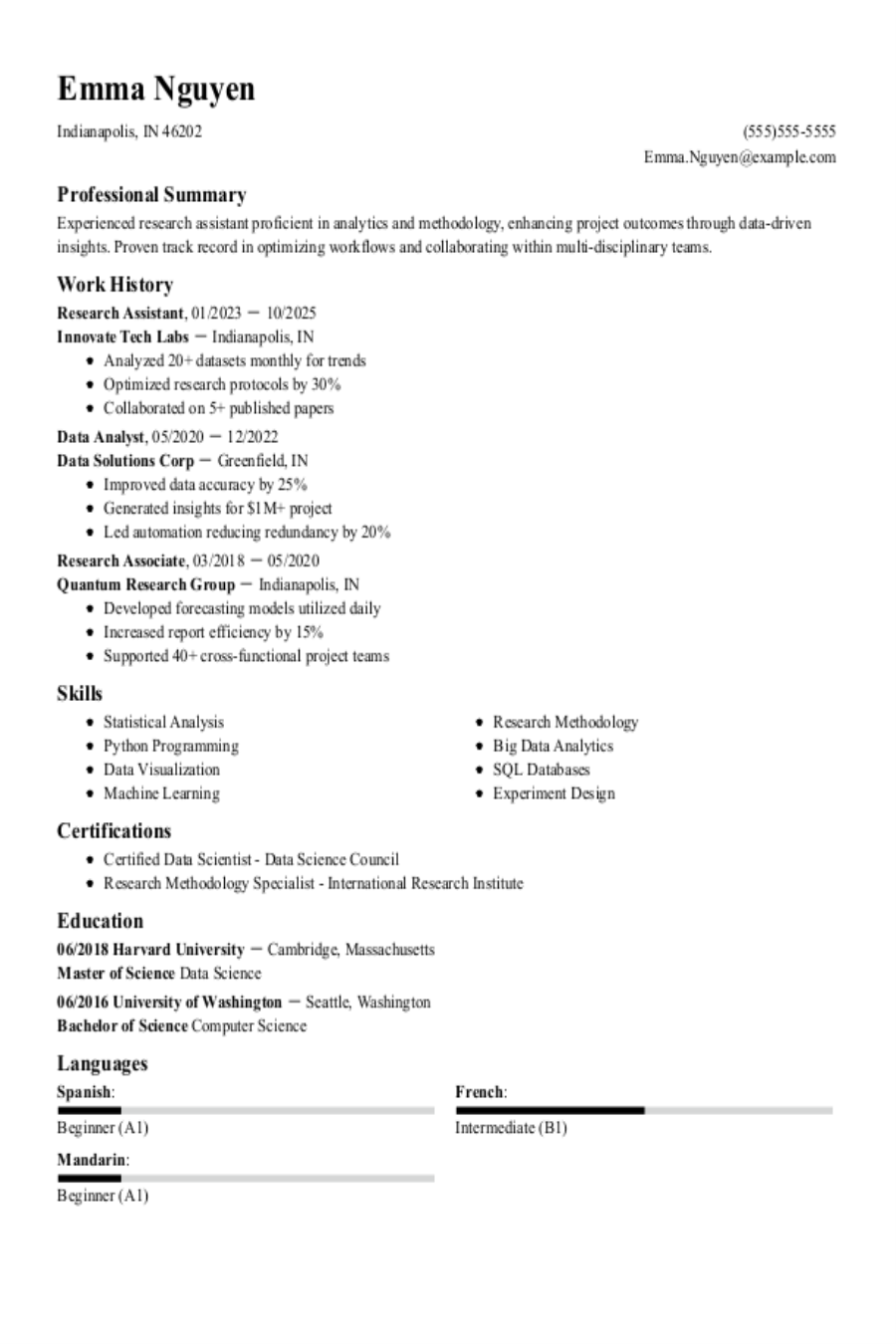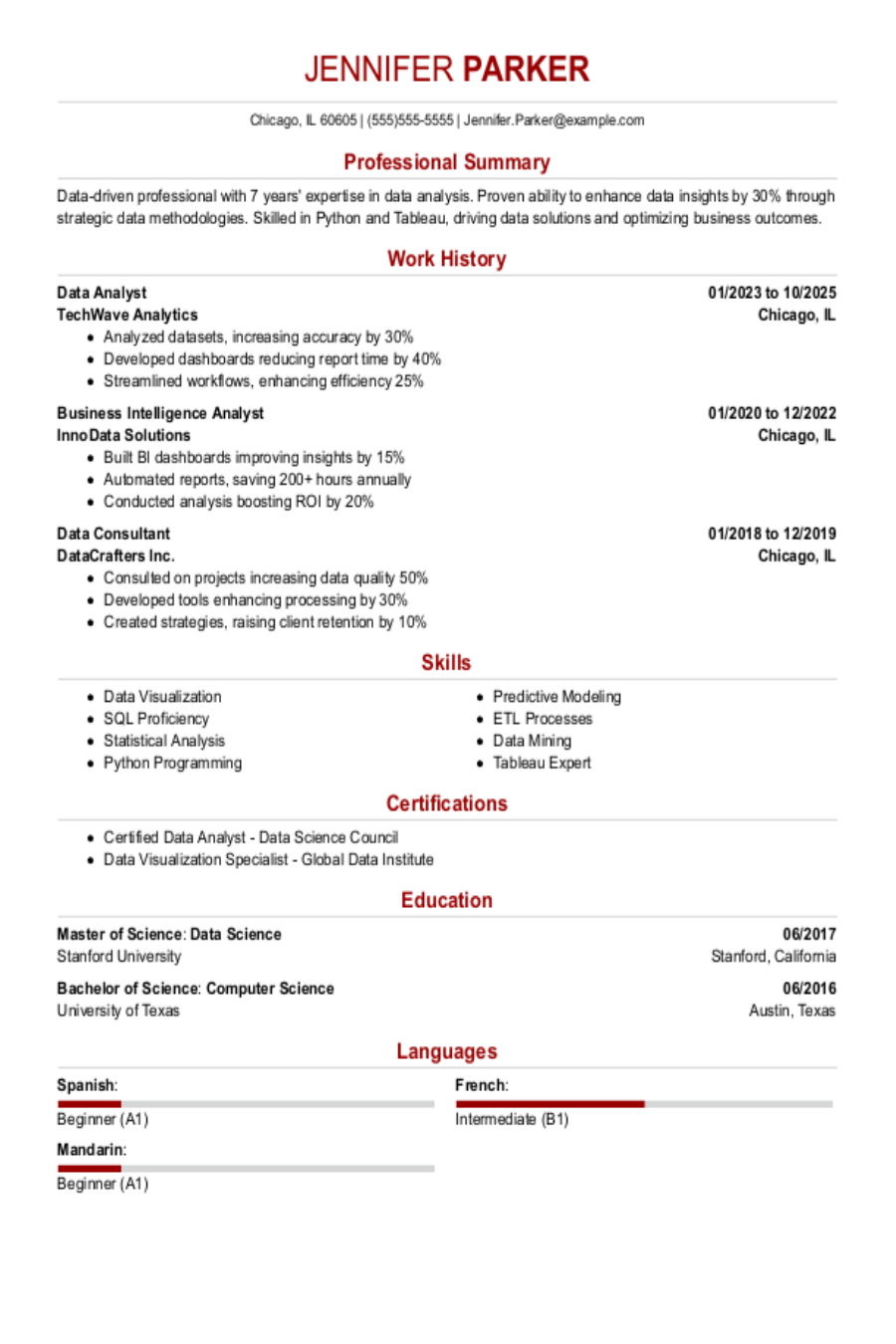Table of contents
In today's job search landscape, LinkedIn skills are one of the most powerful tools for getting noticed by recruiters, boosting your credibility, and standing out in search results. Whether you're updating your profile or just getting started, our guide will help you strategically showcase your strengths.
Here, you'll discover:
- What LinkedIn skills are and how they impact your professional visibility
- Examples of in-demand LinkedIn skills to add to your profile
- Tips to improve and validate your skills through endorsements and assessments
Want to create a resume that complements your LinkedIn in minutes? Try our AI Resume Builder to put together a keyword-rich resume in one of our stylish, ready-to-use templates. Impress employers with your expertise and professional style in just a few clicks.
What Are LinkedIn Skills and Why Do They Matter?
When potential connections view your LinkedIn account, they don't just look at your profile picture or your recent posts. LinkedIn is a unique form of social media that connects you with your professional network while also acting as a type of digital resume.
It's a valuable resource for employers who want to know more about you. In fact, many applicants include links to their LinkedIn profiles in their resume's header to give employers easy access to this information.
This means that when you update your resume for a job, it's a good idea to update your LinkedIn too. Your experience and skills should be displayed on your LinkedIn profile so that employers can see what you're capable of.
How to Add LinkedIn Skills to Your LinkedIn Profile
On LinkedIn, your skills are selected from a list. Navigate to your profile and select "add profile section." From this drop-down menu, you can choose to add a skills section.
As soon as you do, LinkedIn will recommend some possible skills based on your experience. Some of these recommendations will probably be relevant to you, but you should vet them carefully and write in more skills yourself.
Once you've added a LinkedIn skills section to your profile, you can indicate which jobs from your LinkedIn experience section have allowed you to exercise each skill. You can also choose five representative skills to prioritize on your profile—these should be your most critical skills.
Just like a resume's skills section, LinkedIn skills show employers which abilities define your career. Not only that, but LinkedIn allows your professional network to endorse your skills. A robust LinkedIn profile with relevant endorsed skills acts like a social media profile, a resume, and a set of references all at once. But how do you know which skills to include on your LinkedIn page?
How to Choose LinkedIn Skills for Your Profile
LinkedIn offers tens of thousands of skills to choose from, and you can add up to 50 to your page. That's a lot of skills! To take advantage of this feature, don't just fill your LinkedIn profile with the most impressive-sounding skills on the list until you hit 50. Consider these strategies when selecting skills to add to LinkedIn instead:
- Only choose skills that you genuinely have: Honesty really is the best policy when it comes to key professional skills. Employers count on this information to decide if you're qualified. Choosing skills that match your career will also help LinkedIn match you with appropriate roles while giving you real opportunities to have your skills endorsed by colleagues.
- Review some job listings for ideas: Unlike your resume, your LinkedIn profile is unlikely to be tailored to every job you apply for, but job listings can still help you make strategic decisions. Look closely at the descriptions for roles that interest you and pay attention to the skills that they emphasize. Including the skills you have from different job listings will help you build a relevant and targeted LinkedIn profile that gets noticed by recruiters for the exact kinds of roles you're seeking.
- Balance the type of skills you add: In the current professional landscape, it can be easy to fall into the mindset of constantly upskilling and striving for more technical skills. But don't allow your soft skills to get lost in the shuffle! Your skills section should include both your relevant hard skills and soft skills that make you a valuable team player to provide a rounded view of your skill set.
50+ LinkedIn Skills Examples for Your LinkedIn Resume
Whether you're a software engineer, a marketing analyst, or an elementary school teacher, selecting the right blend of LinkedIn skills can have a marked impact on your career. Check out our LinkedIn skills list for options that you can add to your profile today.
When it comes to your specific career, there will probably be many niche skills that your LinkedIn should include. For job-specific skills suggestions and resume-writing tips, check out our library of resume examples.
Core soft skills
Your LinkedIn profile should feature at least a few core soft skills that make up the foundation of your working habits. If your work tends to be more independent or analytical, you may want to emphasize problem-solving and time management, whereas a team-oriented role should focus on showcasing conflict resolution and communication.
Soft skills for your LinkedIn resume
- Communication
- Leadership
- Strategic planning
- Problem-solving
- Decision-making
- Time management
- Critical thinking
- Negotiation
- Conflict resolution
- Adaptability
- Creativity
- Teamwork
- Analytical skills
- Emotional intelligence
- Empathy
- Active listening
- Collaboration
- Mentorship
- Networking
- Public speaking
- Team building
- Delegation
- Motivational speaking
Technological skills and tools
Often, the most critical skills on a resume are the specific technologies required for the role in question. Whether you work with code as a programmer or you use scheduling software as an office manager, computer skills are critical. Make sure to research relevant technology skills for your industry. Here are some frequently required tools:
Common tools and technologies for your LinkedIn profile
- Microsoft Office Suite (Word, Excel, PowerPoint)
- Google Workspace (Docs, Sheets, Slides)
- Adobe Creative Suite (Photoshop, Illustrator, InDesign)
- Salesforce
- WordPress
- HubSpot
- Tableau
- AutoCAD
- QuickBooks
- SAP
- Oracle
- Jira
- Trello
- Slack
- Zoom
- Asana
Industry skills
The technical knowledge that you've gained through your education or experience is key. Show employers that you have the industry know-how and training to exceed their expectations with skills such as the following:
Industry expertise skills for your LinkedIn
- Financial analysis
- Digital marketing
- Content strategy
- Search engine optimization (SEO)
- Social media marketing
- Supply chain management
- Human resources
- Healthcare management
- Education management
- Legal research
- Real estate
- Customer service
- Retail
- Manufacturing
- Public relations
How to Make Your LinkedIn Skills Section Stronger
You've done some research and selected a few relevant skills to display on your LinkedIn profile, but is your profile impressive enough to introduce you to new opportunities?
How can you go beyond a simple skills list on LinkedIn to create a profile that contributes to your professional brand and shows employers that you have exactly what they need?
Try the following strategies:
Build your network
LinkedIn is, first and foremost, a site for making, maintaining, and connecting with your professional network. Your skills are important, but they have a greater impact when your colleagues are able to endorse them. Build a network of LinkedIn connections who know you and your work.
For this task, bigger isn't always better. A large network of total strangers is unlikely to result in any helpful endorsements. Instead, focus on the real relationships you've created at work. Keep in touch with current and past colleagues so that you can mutually support each other's career journeys.
Obtain and display certifications
Your key skills have a big impact on your LinkedIn, and it definitely helps when your connections endorse them, but that's not the only way you can legitimize your abilities. When you obtain relevant certifications in your field, you show employers that your skills are real, that you know how to apply them to real-world problems, and that you're committed to continuously learning and improving in your field.
Take a LinkedIn skills assessment
Beyond seeking out certifications or asking for endorsements from colleagues, LinkedIn offers you a chance to legitimize your skills without even leaving the LinkedIn website. LinkedIn's skills assessments give you a chance to test your skills and display your proficiency level on your LinkedIn profile.
A failed assessment doesn't hurt your profile—although you may have to wait a few months before retaking the test—but a passed assessment gives you a badge that shows you've proven your knowledge in that particular area. Some employers may invite you to participate in skills assessments as well, so there are certainly hiring departments that take this function seriously.
More Skills Resources
Looking for help displaying your skills on your resume? Check out our articles on various key resume skills, including lists of skills to use on your resume, definitions, and tips for improving your proficiency:
- Transferable skills
- Writing skills
- 21st-Century skills
- Employability skills
- Unique skills
- Conceptual skills
- People skills
- Organizational skills
- Project management skills
- Critical thinking skills
- Decision-making skills
- Problem-solving skills
Key Takeaways
Add LinkedIn skills to your profile
LinkedIn offers tens of thousands of skills to choose from. Navigate to your profile settings to add a skills section and begin displaying your most critical skills to employers and colleagues.
Choose relevant skills for your field
Pay attention to job listings in your desired field as you choose which skills to highlight on your LinkedIn profile.
Add both hard and soft skills
Your LinkedIn should feature technical skills related to your field and soft skills that show employers your interpersonal capabilities and working habits.
Showcase technical knowledge
Whether it's industry expertise or familiarity with technical tools, make the most of your digital presence by highlighting your hard-earned knowledge.
Build a network that supports your skills
Skill endorsements from your network help show employers that you've demonstrated your value to past employers and colleagues.
Prove your proficiency
Whether you do so externally with certifications or internally with LinkedIn skills assessments, make your skills concrete by demonstrating your real-world expertise and growth.
Was this information helpful? Let us know!
Hailey is a career advice writer dedicated to helping job seekers excel in their careers.
More resources

How to Include Networking Skills on a Resume (40+ Examples, Definition & Tips to Improve)
What are networking skills? We ll answer this and all your p...

RoboBossing: 66% of Workers Say AI in Leadership Would Make the Workplace More Fair and Efficient
Resume Now s latest report finds growing support for thoughtfu...

Substitute Teacher Resume: Examples, Templates and Tips
Our resume examples templates and writing tips will help you ...

Research Assistant Resume: Examples & Templates for 2025
Was this information helpful? Let us know &star &star &star &s...

Data Analyst Resume: Examples, Templates & Tips
Need a data analyst resume that gets interviews? Our guide can...

